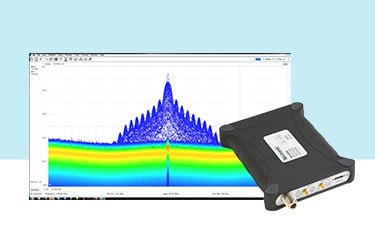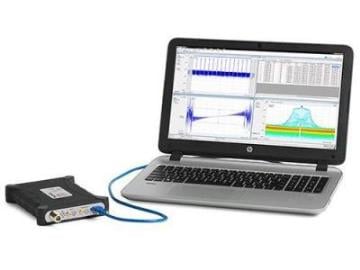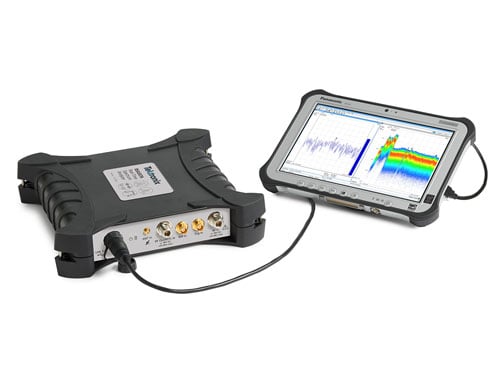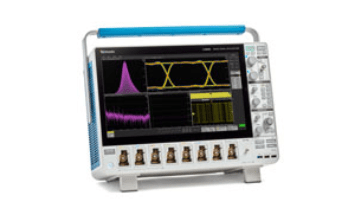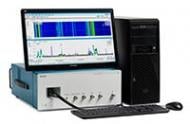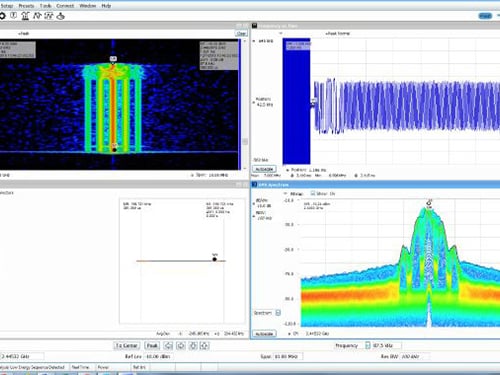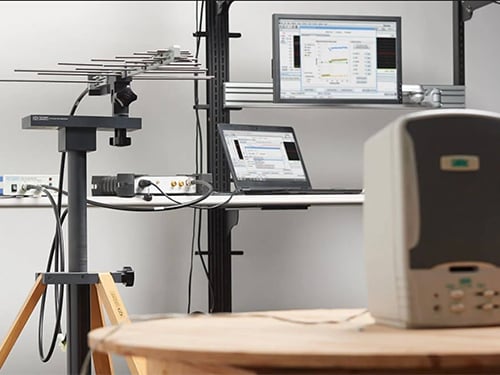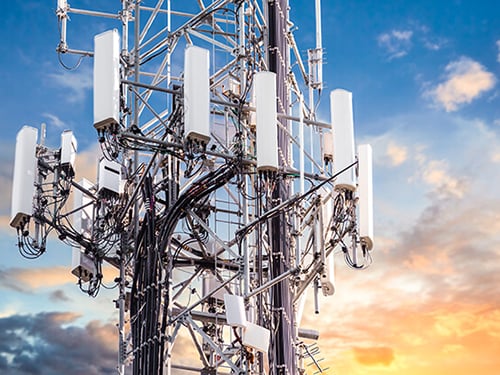與我們聯絡
與 Tek 業務代表即時對談。 上班時間:上午 6:00 - 下午 4:30 (太平洋時間)
請致電
與 Tek 業務代表即時對談。 上班時間:上午 8:30 - 下午 5:30 (太平洋時間)
下載
下載手冊、產品規格表、軟體等等:
意見回饋
瞭解射頻測試:無線系統成功的關鍵
射頻 (RF) 測試是量測及分析,用於在各種應用 (從無線通訊和廣播到雷達和衛星系統) 中傳輸訊號的電磁波的過程。射頻測試涉及評估這些訊號的效能、強度和品質,以確保它們滿足特定標準和要求。這對於射頻組件和系統的開發、驗證與維護至關重要,因為它有助發現可能影響無線通訊與感應系統功能和可靠性的任何問題。此外,射頻測試可確保電磁相容性 (EMC)(涵蓋放射性和干擾耐受性),對於防止干擾並確保電子設備在其環境中諧調運作至關重要。
瞭解如何達成以下事項:
什麼是射頻測試?
射頻測試對於確保無線通訊系統和電子設備的最佳效能和可靠性至關重要。透過進行全面的射頻測試,工程師可以偵測及解決與訊號完整性、干擾和整體系統效率相關的問題。這不僅提升了無線電組件和系統的品質與功能,還可確保符合產業標準和監管要求。有效的射頻測試可以最大限度減低代價高昂的故障風險及提升營運效率,並讓人們相信無線技術將在現實工況下按預期發揮作用。最終,射頻測試對於開發、認證及維護依賴射頻的設備(從日常消費性電子產品到專用工業設備)至關重要,有助企業在當今超互聯世界中獲得競爭優勢。
頻率(頻譜)與時域分析
瞭解頻率 (頻譜) 和時域分析之間的差異和相似之處,對於有效的射頻 (RF) 測試至關重要。每個域都提供獨特的深入分析,並用於優化及確保無線通訊在受監管頻率配置內的正常運行。
頻(頻譜)域分析
定義:頻率(頻譜)分析是評估電磁訊號的頻譜以確定及量測其特性(如振幅、頻率和相位)的過程。透過使用頻譜分析儀,工程師可以檢測及診斷訊號干擾、亂真發射和諧波等問題。頻譜分析可以精確識別一定頻寬內的不同訊號源,確保系統高效運作且不會受到不必要的干擾。它是無線通訊系統、廣播設備、雷達和其他射頻應用的開發、測試和維護用基本工具。
用例:頻譜分析在多個產業中均非常重要,包括行動數據網路和無線通訊、廣播、雷達和國防、航太、醫療設備、研發、法遵測試和工業應用,這是因為電磁頻譜受到 ITU、FCC 和歐盟等各組織的嚴格監管。它確保設備符合這些法規,有助有效管理頻譜,並識別干擾源。
挑戰與解決方案:頻率分析面臨幾項關鍵挑戰,包括管理日益擁擠的頻帶、識別並減輕訊號干擾及確保複雜環境中的準確量測。工程師還必須因應無線技術的快速發展,這需要不斷升級測試方法和設備。此外,在優化訊號效能的同時保持嚴格遵循監管標準使得現況更為複雜。鑒於這些挑戰,需要先進的儀器和軟體來確保射頻系統運行的可靠和高效。
時域分析
定義:時域分析檢查射頻訊號的長時間變化情況,重點關注相位、振幅和頻率的變化。透過它,可深入瞭解信號的動態特性。
用例:射頻訊號的時域分析具有幾項關鍵優勢,包括即時擷取及分析暫態事件和非重複訊號行為的能力。此方法提供有關訊號振幅、相位和計時特性的詳細見解,從而實現了精確的故障排除和 RF 系統優化。時域分析對於識別快速上升緣、脈衝訊號、相位鎖定迴路、頻率變化和同步問題特別有效。
挑戰與解決方案:時域的主要挑戰是快速變化訊號的準確特性分析,對於進階通訊系統和雷達技術至關重要。高頻寬時域分析可以準確捕捉時間上的微小變化,並將其與頻域中的訊號行為相串連,從而有助解決此問題。
射頻測試(RF測試)的重要工具和系統
射頻測試對於確保無線通訊和感應設備的效能和效率至關重要。我們在此重點介紹射頻測試中使用的基本工具,包括即時頻譜分析儀、示波器和任意波形產生器,每種工具在測試過程中都能發揮其獨特作用。
射頻測試硬體與系統
即時頻譜分析儀 (RSA)
主要功能:
- 高速效能:RSA 專為快速、無間斷擷取和分析高頻寬 RF 訊號而設計。
- 即時功能:與傳統頻譜分析儀不同,RSA 在其瞬時頻寬內即時處理訊號,使它們能夠擷取其他儀器可能錯過的暫態事件。它們能夠對複雜的通訊和雷達訊號進行徹底分析。
應用:在速度和準確性至關重要的環境中,RSA 必不可少,例如在測試動態無線訊號和複雜的干擾場景中。
常用地點:
- 實驗室環境:RSA 通常在研發實驗室中用於開發無線技術的新組件和系統,其中即時分析對於檢測快速移動的異常和雜散訊號至關重要。
- 製造設施 (Fab):在製造測試中,RSA 確保產品滿足所需的射頻和放射性規格,並有助在到達終端使用者之前校準其射頻功率。
- 現場測試:工程師使用可攜式 RSA 進行現場診斷、故障排除及現場系統驗證,尤其是在雷達、電訊和廣播領域。
示波器
主要功能:
- 多種頻寬選項:暫態頻寬範圍從幾 MHz 到數 GHz 不等。
- 多通道型號:提供 2、4 和最多 8 通道設定,提升同時監控多個訊號的能力。
應用:示波器對於詳細分析電子訊號的時域特性至關重要,尤其適用於偵錯和訊號完整性檢查的研發環境。
常用地點:
- 實驗室環境:對於電子訊號定時行為的研究、開發和驗證至關重要。
- 製造設施 (Fab):用於確保電子設計和系統在生產過程中滿足嚴苛的時序標準。
- 現場測試:可攜式型號用於診斷和排除實際作業環境中的問題,例如通訊基礎結構現場。
任意波形產生器 (AWG)
主要功能:
- 靈活性:AWG 的功能無與倫比,可以生成任何波形,依據特定的測試條件進行客制化,無論是單次出現還是重複訊號皆是如此。
應用:AWG 在模擬複雜波形和測試不同訊號條件下的設備響應方面,特別有價值,有助於開發強大且高效的無線設備。
常用地點:
- 實驗室環境:廣泛用於設計和測試階段,模擬及分析不同的訊號場景。
- 製造設施 (Fab):對於驗證最終產品功能和現實工況壓力測試至關重要。
- 現場測試:在真實環境中生成測試系統回應所需的特定訊號非常有用。
射頻測試軟體概述
軟體在射頻測試中發揮著至關重要的作用,透過先進的訊號處理、分析和模擬功能來增強硬體的功能。
主要功能:
- 訊號分析:軟體工具提供涵蓋廣泛的分析結果,有助工程師瞭解頻譜利用率、訊號調變品質、系統穩定性和效能。
- 模擬功能:射頻測試軟體可以模擬複雜的無線環境和信號交換,使工程師能夠預測設備在真實場景中的效能。
- 自動化測試:許多射頻測試軟體套件都包含自動化功能,可簡化測試過程、減少人為錯誤並提升可重複性和效率。
- 資料管理:有效的軟體有助整理、儲存及擷取測試資料,從而簡化報告和相容性追蹤。
應用:
- 設計驗證:軟體在設計階段被廣泛使用,以對無線電系統的所有關鍵射頻參數進行特性分析,驗證其案例,並確保無線電設備的電磁相容性和訊號完整性。
- 法規遵循:透過細緻的校準和測試程序,確保所有無線設備符合全球通訊標準和法規。
- 效能優化:透過提供不同作業參數下設備行為的詳細回饋,幫助調整設備在各種工況下實現最佳射頻效能。
試用射頻測試的附件和轉接器
配件和轉接器在擴展射頻測試設備功能、確保準確高效的量測和分析面向不可或缺。
主要功能:
- 纜線和接頭:高品質纜線和接頭對於在測試期間保持訊號完整性至關重要。它們必須匹配系統阻抗,以免反射和損失。
- 訊號衰減器:用於降低訊號功率,而不會使其波形顯著失真。衰減器對於保護敏感設備免受高訊號位準的影響至關重要。
- 天線:不同的測試可能需要不同類型的天線來準確捕捉或發射訊號。必須依據測試所需的特定頻率和輻射方向圖來選擇天線。
- 轉接器:這些有助連接不同類型的接頭和纜線,確保各種測試設備之間的相容性。
- 校驗套件:須使用相應的校驗套件進行定期校驗,以確保射頻測試設備提供準確且一致的結果。
應用:
- 擴展測試範圍:高增益天線和寬頻纜線等配件允許在更廣泛的工況和設定下進行測試。
- 訊號特性:使用正確的轉接器和纜線可確保在測試期間不會改變訊號,以利進行更準確的特性分析。
- 設備相容性:轉接器和校驗套件有助保持測試設備的通用性,使其與各種設備和標準相容。



